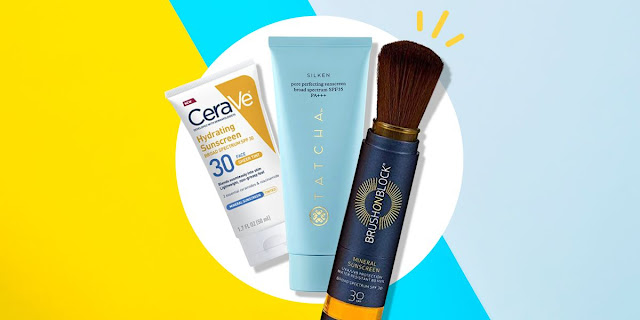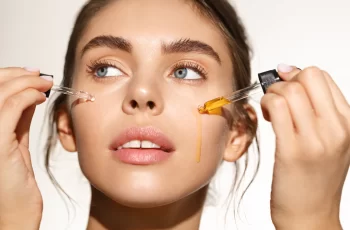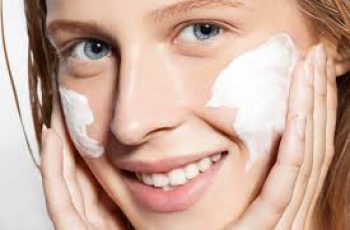Can Retin A and Hyaluronic Acid be used together?
Retinol and hyaluronic acid are undoubtedly two of the most impressive skincare ingredients out there, with impressive results and backed by a wealth of scientific research. It’s no wonder that many of us would like to combine these powerful ingredients, but the question is: can Retin A and Hyaluronic Acid be used together? That’s exactly what we’ll be taking a closer look at in today’s blog post, but before we get started, let’s quickly summarize what hyaluronic acid and Retin A do for your skin and what you can expect.
What is Hyaluronic Acid?
Hyaluronic acid occurs naturally in the body and is responsible for keeping the skin, joints, and tissues hydrated and in their healthiest state.
When it comes to skincare formulas, hyaluronic acid is extracted from sugar cane and blended into a range of products to leave skin hydrated, plump, and radiant.
It works by drawing moisture from other skincare products to the facial area and trapping it in the skin. This strengthens the skin’s protective barrier and protects against exposure to free radicals such as pollution and UV rays, which can cause skin damage and other issues.
You’ll find hyaluronic acid is suitable for all skin types, including dry, sensitive skin. It’s also one of the few ingredients that can be combined with almost any other skincare product. Its hydrating effects on the skin mean it can counteract irritation caused by stronger ingredients.
For more information on hyaluronic acid, check out our dedicated blog post on hyaluronic acid and its skincare benefits.
What is Retin-A?
Retinoic acid, also known as tretinoin, is a potent form of vitamin A that is favoured by many to fight signs of ageing while treating acne.
Retin-A is often mistakenly referred to as an exfoliant, but it speeds up the skin’s natural cell renewal cycle. This removes dead skin cells from the skin, revealing fresh new skin underneath, leaving you with a radiant, vibrant complexion.
Signs of ageing such as fine lines and wrinkles are combated, while loss of skin firmness is also addressed with the help of Retin-A, as it works in the lower layers of the skin to boost collagen production for a firmer, more youthful-looking face.
If you’d like to learn more about Retin-A and its skin benefits, you can find a dedicated blog post on The Beauty Insiders.
Can retinol cream and hyaluronic acid be used together?
Yes, you can definitely use hyaluronic acid and retinol cream together. You’ll often find multiple skincare products that have both ingredients in one formula. This is considered the easiest way to combine two powerful ingredients and reap the benefits as quickly as possible. However, there’s nothing wrong with using hyaluronic acid and retinol separately. Start with the retinol and let it absorb into the skin before applying the hyaluronic acid, as this will lock moisture into the skin’s surface and counteract the common drying side effects of using any form of vitamin A in your daily routine.
Which comes first, hyaluronic acid or tretinoin?
This largely depends on the type of product each ingredient is added to. A basic skin rule is to apply skincare products in order of consistency, from thinnest to thickest.
You’ll often find hyaluronic acid in serums and moisturizers that you apply to your face later in your skincare routine. Retin-A, for example, is often found in moisturizers and creams. Once you decide which product to use first, you’ll find that combining the two ingredients can lead to a brighter, more radiant complexion with minimal skin irritation or side effects.
I still recommend doing a 24-hour patch test before applying any ingredient or formula to your face. It’s the best way to avoid unnecessary irritation.
What is the difference between Hyaluronic Acid and Retin-A?
Although hyaluronic acid and Retin-A work in the same way, they work very differently on the skin. The easiest way to remember the difference is to think of hyaluronic acid as a big glass of water for your skin. The hydrating properties of the acid keep water constantly absorbed into the skin and retained on the surface. This is where the skin’s protective barrier resides, and when that barrier weakens, it can lead to skin damage such as: B. Sun-induced hyperpigmentation, fine lines and wrinkles caused by pollution, and many other environmental aggressors that cause long-term damage to the skin.
Does hyaluronic acid make wrinkles worse?
Not really, but you can have too much of a good thing. What I mean by that is that using large amounts of hyaluronic acid can cause moisture to be sucked out of the lower layers of the skin. This can have a general drying effect on the skin, and over time, fine lines and wrinkles can become more noticeable and often appear deeper than they really are.
To combat this, I recommend stopping the use of hyaluronic acid for a few days to allow the skin to rebalance. You should then reintroduce the acid and apply an appropriate amount to your face, which will help keep your skin hydrated, plump, and healthy.
Here’s more information on whether you can use Retin-A and hyaluronic acid together. If you have any other skin care questions, don’t forget to follow us on Instagram. You can reach me via private message. I look forward to seeing you there!
DQH Knowledge drop: In your 20s, your skin cell turnover decreases. (Cell turnover is a key component in keeping your skin youthful.) You know what else slows down? Your collagen production. Starting in your 20s, collagen decreases by about 1 percent per year. Should you want to prevent fine lines and wrinkles, start by eliminating behaviors that contribute to premature aging. “If it’s bad for you, it’s bad for your skin,” says dermatologist Michel Somenek.
“Cigarette smoking reduces blood flow to the skin and causes premature wrinkling and a dull skin texture. Making the repeated pursed motion to inhale can also cause smoker’s lines. Alcohol and recreational drugs are toxins for the skin that damage its cellular structure and DNA,” Somenek tells us. “The faster you eliminate vices while you are young, the better chance your skin and body have to recuperate.” Also, adopting an anti-aging routine in your 20s is key. After all, the best offense is a good defense. We spoke to Somenek and experts Joshua Ross and Audrey Kunin to find out more.
Keep reading for the best anti-aging products for your 20s, according to skincare professionals.
Sunscreen
“We all know that the sun is the number one cause of skin aging and starting the prevention in your 20s is very important,” Ross says. “The majority of your sun damage won’t start to appear until you’re in your 30s, so don’t wait until you see it surface or you’ll be behind the curve. Stay ahead of it with a good-quality zinc-based sunscreen worn daily.”
Farmacy Green Defense Daily Mineral Sunscreen
An invisible sunscreen with SPF 30, plus botanical extracts meant to protect skin with tons of antioxidants. Bonus: It’s clean and fine to use under makeup.
Bareminerals Complexion Rescue™ Tinted Moisturizer Broad Spectrum SPF 30
Although we recommend you use your SPF and moisturizer separately, we also understand moments when you don’t have time or energy for that extra step. For those times, this bareMinerals moisturizer is a great thing to have on hand.
Vitamin C Serum
“A great introduction to anti-aging is to start with a vitamin C serum in your morning skincare routine,” Ross says. “It’s a powerful antioxidant that will neutralize free radicals and brighten the skin.” He adds that it’s a great way to counteract the effects of the sun’s harmful rays, which, as previously mentioned, are among the biggest causes of premature aging.
Drunk Elephant C-Firma™ Vitamin C Day Serum
The Drunk Elephant C-Firma is a lightweight serum that promises to give skin a glow by combining the brightening powers of vitamin C with ferulic acid, l-ascorbic acid, and vitamin E. The included sodium hyaluronate is meant to replace hydration loss, so you shouldn’t have to deal with any irritation.
Sunday Riley C.E.O. Rapid Flash Brightening Serum
This potent serum is jam-packed with vitamin C (15 percent, to be exact), which means it’s a potential superstar at both brightening skin and dousing it in antioxidants.
Peptides
Using peptides on your skin has many benefits, says Somenek. “The skin barrier is what defends the body against pollution, UV rays, bacteria, and toxins. It can be damaged by several everyday factors. Using topical peptides aids in building a stronger barrier,” he says. “Peptides comprise elastic fibers, which are a type of protein. These fibers help to make skin appear taut and firm. Peptides can also help repair damaged skin, relieve inflammation, and even out skin tone. Some peptides can kill acne-causing bacteria that is common in 20-somethings.”
Kunin agrees, saying, “Peptides are an excellent entry point for supporting collagen.” She recommends looking for face and eye treatments that contain these collagen-boosting powerhouses.
Charlotte Tilbury Magic Eye Rescue Cream
This Charlotte Tilbury super-emollient eye cream has a base of coconut oil and shea butter (read: it’s incredibly hydrating). Botanicals plus peptides are meant to help reduce dark circles and boost collagen, respectively.
This creamy moisturizer serves up potent collagen-boosting peptides and pycnogenol, and antioxidant-rich vitamin C. “Instead of sitting on top of the skin, peptides penetrate the outer layer so they go deep. The ‘signals’ they send tell the cells to produce elastin and collagen, which are needed for youthful-looking skin,” explains Somenek.
At-Home Peel Pads
Remember that skin cell turnover fiasco we talked about earlier? One way to help support it is by exfoliating. “Exfoliation is important to help keep skin fresh and luminous,” Kunin says. She recommends using at-home peel pads as an easy and effective way to exfoliate.
“The goal in your 20s is to fight the slowing pace of cell turnover. It is wise to use products that gently exfoliate, yet still remove oil and other impurities. Products that have Alpha Hydroxy Acids (AHA) or Beta Hydroxy Acids (BHA) are a good choice.”
According to Somenek, you should only exfoliate two to three times a week. “People of all ages are guilty of over-exfoliating and that can be too much of a good thing,” he says.
Dermadoctor Kakadu C Intensive Vitamin C Peel Pad
A few swipes of this Derma Doctor powerful peel pad promise to leave your skin glowing and smooth, thanks to the seven (yes, seven) types of chemical exfoliants, including AHA and BHA. It also contains vitamin C via Kakadu plum extract for added brightening and antioxidant protection.
KEY INGREDIENTS Kakadu plum extract is sourced from the Kakadu plum, a fruit grown in northern Australia. It contains vitamin C, which restores the skin’s natural barrier, increases collagen production, and soothes irritation.
Dr. Dennis Gross Skincare Alpha Beta® Universal Daily Peel Pads
These are the gold standard of peel pads, with a cult following and over 900 five-star reviews on Sephora. They’re easy to use and contain a blend of anti-aging exfoliating acids.
Emollient Night Cream
“In your 20s, you need to start upping the hydration in your skincare routine. You may have been cautious of over-moisturizing because of acne in your teens, but as you enter your 20s, your skin transitions and becomes drier,” Ross says. “I recommend an emollient night cream added into your evening skincare regimen.”
“Twenty-somethings need to make sure that they are not using creams that will clog their pores and cause excess oil production,” says Somenek. Opt for non-comedogenic products.
Cerave Skin Renewing Night Cream
One great choice is the CeraVe Skin Renewing Night Cream, which is a non-comedogenic night cream that leaves skin soft and glowy. It combines the moisturizing powers of ceramides and hyaluronic acid.
RoC Retinol Correxion Max Hydration Creme
“The best night cream ingredients contain retinol, benzoyl peroxide, and/or salicylic acid or hyaluronic acid. The goal is to moisturize, yet remove excess oil,” says Somenek. This Roc Retinol Correxion cream fits the bill as it contains both hyaluronic acid and retinol so it promises to moisturize while also being non-comedogenic.



